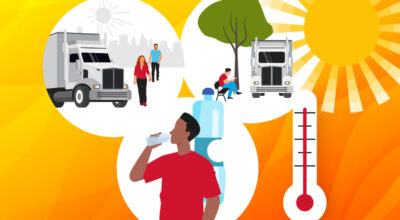
Safety in the age of COVID-19 often refers to stocking up on hand sanitizer, practicing social distancing and wearing masks. For truck drivers, who encounter dangerous road situations as a regular part of their job, staying safe adds another layer.
This is particularly true when it comes to navigating busy construction zones, which can be challenging for even the most seasoned truck drivers.
According to the Federal Highway Administration (FHWA), 30 percent of all work zone crashes involve large trucks, and many of them prove to be fatal. From 2014 to 2018, work zone crashes led to 1,000 fatalities and over 18,000 injuries, according to the FHWA’s most recent data.
Avoid being another statistic and use these tips to navigate construction zones safely.
Plan ahead
Before you get on the road, check your GPS or use a travel app, such as Waze, to see if there is construction on your route, and consider leaving earlier in anticipation of reduced speeds. Better yet, look into an alternative route. It may be slightly longer, but chances are you will ultimately save time–and frustration–by avoiding construction-related traffic and road hazards.
Follow the signs
Those cones, barrels and work zone signs are there for a reason (and that reason is not “to annoy you”). They’re there to help you navigate the construction zone and keep traffic moving as much – and as safely – as possible.
Don’t try to game the system
It may be tempting to speed through a construction zone when you think the coast is clear, but it is absolutely critical that you stick to the reduced speed limits. In 2018, speeding was to blame for over 25 percent of fatal work zone crashes.
Even if you think you’re perfectly capable of getting through a work zone without slowing down, the drivers around you may not be so adept. Should something unexpected happen, you will be in a better position to stop or navigate around it if you’re obeying the speed limit.
Watch for flaggers
Oftentimes, traffic routes and detours change so quickly during construction, it’s easier to have a flagger out on the road conducting traffic. If you see a flagger, pay attention and follow their direction as you would any other work zone signage. After all, they’re not out there for their health – they’re out there for yours.
Play defense
If ever there’s a good time to practice those defensive driving skills you learned way back in driver’s ed, this is it. While you may be paying attention, the drivers around you might not be. As you’re driving, be mindful of other drivers who may be trying to merge at the last minute, speeding or driving erratically.
Give yourself space
Rear-end collisions are one of the most common types of work zone crashes and accounted for 21 percent of fatal work zone crashes in 2018, according to the FHWA. Leave plenty of distance (about three to four seconds) between you and the driver ahead of you, as you never know when they may stop suddenly.
While you’re at it, try to see what’s happening further down the road, so you can prepare to slow down or change your route if necessary.
Keep your eyes on the prize
A distracted driver is a dangerous driver. Avoid texting, eating or checking out the construction around you – anything that forces you to take your eyes off the road, even if it’s “just for a second.”
Accidents can happen in an instant, so stay alert and focused on the task at hand for your safety – and everyone else’s.
The #1 priority at Centerline is safety. Learn more about safety topics by visiting our safety resource center here.


